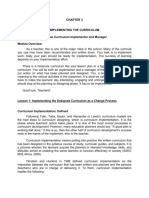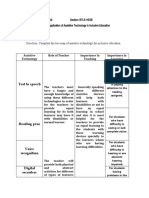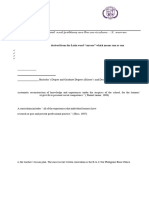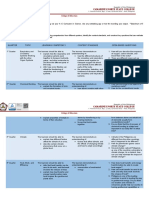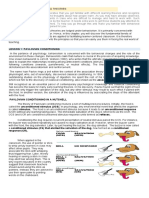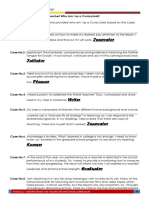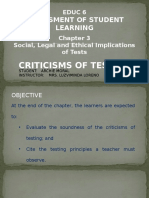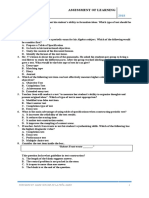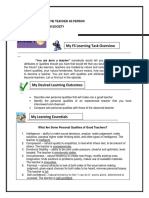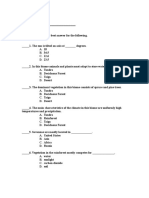Curr Dev 5 Met
Uploaded by
Anastasia EnriquezCurr Dev 5 Met
Uploaded by
Anastasia EnriquezPrinciples of Teaching
12. Teacher A, a newly hired science teacher, calls a student, then asks a question during the recitation. Is this right or wrong?
A. Right, because it is the teacher’s prerogative
B. Wrong because the student does not know the answer
C. Wrong because the question is particularly directed to the called student
D. Right because it encourages the students to prepare for the recitation.
21. Which of the following best describes “Portfolio Assessment”?
A. An individual learner is adequately characterized by the test score
B. An individual learner cannot be solely assessed by his test score
C. It is a dynamic, ongoing, and collaborative gathering of multiple indicators of student progress
D. Assessment of acquired knowledge through test results
18. Which of the following instructional objective is in accordance with Bloom’s highest level of Cognitive Taxonomy?
A. Explain the concept of variation
B. Identify the different measures of variation
C. Compare and contrast Quartile Deviation and Standard Deviation
D. Compute the standard deviation of a test
13. Which of the following questions demand the highest level of thinking?
A. How should you present your report?
B. Was the student’s reporting well done? Support your answer
C. What steps in reporting are you taking?
D. What conditions must be met to have an effective reporting?
2. What method do you apply when you begin your lesson with concrete life experiences then lead your students to abstract
thinking?
A. Interactive
B. Deductive
C. Inductive
D. Transductive
6. Which of the following situation would indicate that you, as a teacher, had been effective in instilling discipline among your
students?
A. Students behave because an award awaits them
B. Your presence results in their being behaved
C. Students have developed concern for each other
D. Fear and fright resulting in good behavior
61. Which among the following is the most valid statement concerning the aim of a lesson?
A. Announcement of the aim at the start of each period
B. Aim is outgrowth of and developed from motivations
C. Aim should be written at the blackboard
D. Aim should be written by the student on his notebook
62. Repetition will facilitate learning process when?
A. Done in different settings
B. Kept short as possible
C. There is short intervals between repetitions
D. Given in the same form each time
63. In individualized instruction, how should the teacher begin?
A. Evaluate teaching-learning outcome
B. Present activities needed
C. Identify abilities of learner
D. Prepare the necessary materials
43. The teacher should give ______ to enhance the learning abilities of slow-learners.
A. Assignments
B. Enrichment
C. Reinforcement
D. activities
KARLAS RESEARCH
You might also like
- Curriculum Development Module 3 Foundations of Curriculum DevelopmentNo ratings yetCurriculum Development Module 3 Foundations of Curriculum Development3 pages
- Constructivist Teaching: Interactive, Collaborative, Integrative and Inquiry-BasedNo ratings yetConstructivist Teaching: Interactive, Collaborative, Integrative and Inquiry-Based23 pages
- The Teacher As A Person in The Society: Field Study100% (1)The Teacher As A Person in The Society: Field Study12 pages
- Behaviorism, Cognitivism, ConstructivismNo ratings yetBehaviorism, Cognitivism, Constructivism14 pages
- PRINCIPLES OF HIGH QUALITY ASSESSMENT (Lesson 2)No ratings yetPRINCIPLES OF HIGH QUALITY ASSESSMENT (Lesson 2)13 pages
- Lecture CH 6 Lecture, Discussion, DemonstrationNo ratings yetLecture CH 6 Lecture, Discussion, Demonstration12 pages
- College of Education: Ed 111 - Professional EnhancementNo ratings yetCollege of Education: Ed 111 - Professional Enhancement28 pages
- Important Points To Remember in Planning and OrganizingNo ratings yetImportant Points To Remember in Planning and Organizing32 pages
- Copy Module 5 8 Final Term Assessment of LearningNo ratings yetCopy Module 5 8 Final Term Assessment of Learning40 pages
- Activity 8 (Designing and Evaluating Portfolio Assessment)100% (1)Activity 8 (Designing and Evaluating Portfolio Assessment)2 pages
- 21st Century Assessments & CharacteristicsNo ratings yet21st Century Assessments & Characteristics2 pages
- An Act Providing For The Establishment and Maintenance of An Integrated System of EducationNo ratings yetAn Act Providing For The Establishment and Maintenance of An Integrated System of Education79 pages
- Famous and Contemporary Approaches To Reading Literature: ExampleNo ratings yetFamous and Contemporary Approaches To Reading Literature: Example3 pages
- BEED - SCIENCE Biology, Chemistry, Earth Sci Etc0% (1)BEED - SCIENCE Biology, Chemistry, Earth Sci Etc11 pages
- Franchise Application - Information SheetNo ratings yetFranchise Application - Information Sheet1 page
- Brand and Demand:: The Key Principles of Marketing GrowthNo ratings yetBrand and Demand:: The Key Principles of Marketing Growth36 pages
- SCHEME OF WORK ADS656 FEB - JULY 2023 New VersionNo ratings yetSCHEME OF WORK ADS656 FEB - JULY 2023 New Version9 pages
- Victoria Elementary School: Region 02 - (Cagayan Valley)No ratings yetVictoria Elementary School: Region 02 - (Cagayan Valley)2 pages
- BACHELORS VIRTUAL FINAL EXAM TIMETABLE - DEC 2024..excel.No ratings yetBACHELORS VIRTUAL FINAL EXAM TIMETABLE - DEC 2024..excel.51 pages
- Cambridge IGCSE™: Global Perspectives 0457/11 May/June 2021No ratings yetCambridge IGCSE™: Global Perspectives 0457/11 May/June 202116 pages
- Presentation Principle of Education in Malaysia: Group 1 Hemalina Koshanah Daisylin Nagajothi NyanamaniNo ratings yetPresentation Principle of Education in Malaysia: Group 1 Hemalina Koshanah Daisylin Nagajothi Nyanamani9 pages
- Nicomedes R. Tubar Sr. National High School Mapeh-P.E Shaina Marie B. Esguerra 1No ratings yetNicomedes R. Tubar Sr. National High School Mapeh-P.E Shaina Marie B. Esguerra 110 pages
- 2069 Example Candidate Responses Paper 2 (For Examination From 2018)No ratings yet2069 Example Candidate Responses Paper 2 (For Examination From 2018)16 pages
- ESBM Evaluation Tool 2020 v2.2CAUSWAGANNo ratings yetESBM Evaluation Tool 2020 v2.2CAUSWAGAN31 pages
- Lesson Plan SP Grade 7 SS Geography T1 W1No ratings yetLesson Plan SP Grade 7 SS Geography T1 W15 pages
- Devi Ahilya Vishwavidyalaya, Indore: School of Commerce Programme Code: Cm4ANo ratings yetDevi Ahilya Vishwavidyalaya, Indore: School of Commerce Programme Code: Cm4A6 pages



